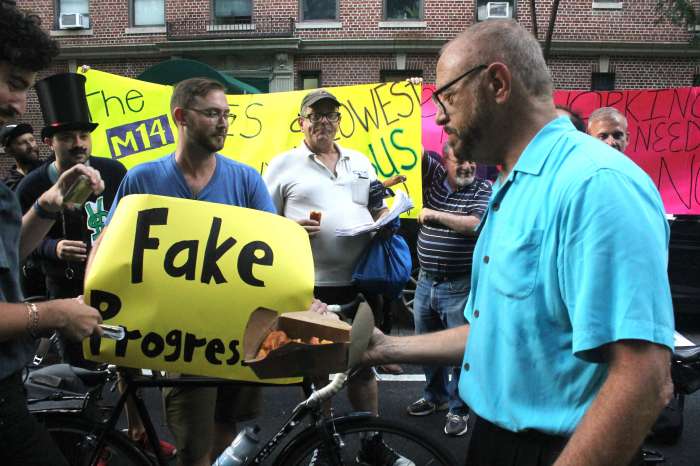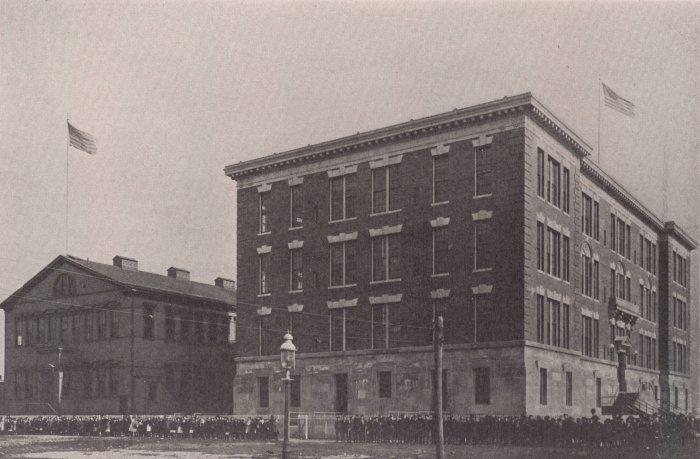No applause for rezoning flaws
To The Editor:
Re “Builder gives up a whole lot, but neighbors are still sore” (news article, Aug. 6):
The Villager article on the rezoning of the southwest Village misses an important point about a flawed process that led to a flawed result. Speaker Christine Quinn’s Office boasts about the relatively small concessions that were made by the developer regarding inclusion of commercial space and affordable housing. Why didn’t the city demand concessions on such basic issues when the developer first proposed the rezoning in the summer of 2007?
When the Greenwich Village Community Task Force and other community organizations initially proposed the inclusion of affordable housing during last January’s Community Board 2 Zoning Committee hearing, the suggestion was dismissed as laughably unrealistic.
When the task force raised questions about irregularities in the way floor area ratio had been calculated on the parking lot owned by developer Peter Moore, our concerns were dismissed as unfounded; until we spent our own time and money to research the records, hire a lawyer and force the Department of Buildings to acknowledge that a mistake had been made. The result is that any new building constructed on the site will be roughly half the size that the developer originally intended.
It fell to the task force and other community groups to highlight the impacts that the original zoning proposal would have had on jobs, school overcrowding, open space and so many other aspects of the neighborhood. Why were all of these issues initially ignored by the city, and why did it take months of kicking, screaming and organizing by the community to get these problems acknowledged?
This rezoning proposal was developer-driven from the beginning. A spot-zoning deal worked out between the speaker’s office and the developer three hours before the final vote was taken is no substitute for a comprehensive zoning process undertaken with full community involvement
Zack Winestine
Winestine is co-chairperson, Greenwich Village Com-munity Task Force
Hospital’s a real operator
To The Editor:
Re “Our knack for defeating ‘absolutely necessary’ projects” (talking point, by Gary Tomei, July 23):
Thank you for printing Gary Tomei’s on-point essay concerning the community dangers of the proposed Rudin/St Vincent’s project. An additional point is that the proposed, new, 21-story hospital tower, with its small footprint and extreme verticality, may not be able to provide the “state of the art” emergency and acute interventional care St. Vincent’s wants.
Were the new hospital to be built, I would predict a swift application to privitize 12th St. between Seventh and Greenwich Aves. for E.M.S. and St. Vincent’s use. Next would come a hardship application for more footprint land adjacent to the O’Toole site — by eminent domain acquisition, if necessary — and, finally, the hospital’s move to a more conducive neighborhood, funded by the sale to a developer of a 299-foot hospital tower that could not otherwise have been built in the landmarked Village community.
C.J. Scheiner, M.D., Ph.D., A.C.S.
Scheiner was an emergency-medicine attending physician at Kings County Hospital, Brooklyn, from 1977 to 2004.
Chair’s report (on report)
To The Editor:
Re “New C.B. 3 chairperson has focused on land use” (news article, Aug. 13):
That was a nice article you wrote profiling me. It’s mostly accurate, except that I have a few points that I feel need corrections.
My first name is spelled Dominic. Funny, because people usually butcher my last name, but you got it right.
I was not a member of the 197A Rezoning Task Force — only on the Housing and Zoning Committee.
The Housing and Zoning Committee had nothing to do with the success of the rezoning plan. The task force handled the whole process and was separate from the Housing and Zoning Committee. I would not have said that Housing and Zoning was instrumental in moving the rezoning through the process. David McWater’s leadership, the committee’s work and the full board were all instrumental in moving it through the process.
I was on the Community Education Coun-cil for School District 1. While our board incorporates part of District 2, C.E.C. 1 is entirely within our board and has different challenges than C.E.C. 2. People on C.E.C. 2 reading this article may be wondering who I am.
I want to clarify that the Board’s S.L.A. Committee does hear all license applications within the moratorium area now, per the request of the New York State Liquor Authority. We do maintain that an application must provide a significant public benefit for approval. If it doesn’t, we will deny and explain why to the S.L.A. Same goes for any applications falling within the 500-foot rule.
Also, if a bar were to apply for a license, not posing as a restaurant, we would give this applicant a fair hearing. The way the article is written, it sounds like we are looking out for bars specifically to reject. We are not anti-bar. There is a general consensus on the committee, though, that operators should be upfront and truthful with their method of operation. For any applications below Delancey St., these will undergo heavy scrutiny, but a bar could theoretically be approved and a restaurant disapproved for a variety of reasons. I don’t want to be interpreted as being anti-bar. I believe in balance.
Dominic Pisciotta
Pisciotta is chairperson, Community Board 3
Free press: Best defense
To The Editor:
I would like to thank Lincoln Anderson and The Villager staff for the excellent coverage of our efforts to obtain the permits for the 20th anniversary of the Tompkins Square police riots. This was a two-year struggle and is a good example of the press helping to keep in check the government bureaucrats that would deny our First Amendment rights. There will come a day when the interference to freedom will be put in final checkmate. Until that day arrives, a free and involved press is our first line of defense against what could very easily become a police state.
Jerry The Peddler
Another take on rezoning
To The Editor:
Re “Rhetoric on rezoning ramps up as public review continues” (news article, Aug. 13):
Your article contains several errors. You write that Mr. McWater “advocated for the downzoning.” This plan is an upzoning. According to City Planning’s own $2 million study of the rezoning, the plan will bring 53.9 percent more development than current zoning would bring.
Rezoning proponents do not understand that height caps merely redistribute development across more buildings. Air-rights transfers, which preserve buildings, are effectively eliminated under this contextual plan, encouraging all buildings to rise uniformly to the new height allowance, hence, 53.9 percent more development under the rezoning.
Damaris Reyes’s claim that “60 percent of people who live in the zones are of color” is false. According to 2000 census figures, 48 percent of the rezoning area was white. Since 2000, market-rate residential development — most of it under 80 feet tall and hardly any of it community facility — has brought many more whites. Today, the majority is certainly white.
Also false: Mr. McWater’s claim that including the housing projects would raise the height cap. As he well knows, the Department of City Planning considers subareas for their caps, such as 75 feet for East Village side streets, 80 for the avenues; a small area south of Tompkins Square Park even received its own F.A.R. cap of 3.0.
The public is not being told the truth. Our community leaders should carefully read City Planning’s study of the upzoning. They will find, among other gems: The rezoning will bring, at most, 10 percent affordable housing. To get the desired 30 percent, the “I.Z.” (inclusionary zoning) would have to be 60 percent affordable, eliminating the incentive entirely.
Rob Hollander
Hollander is a member, Lower East Side Residents for Responsible Development















